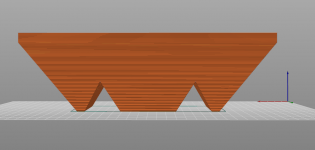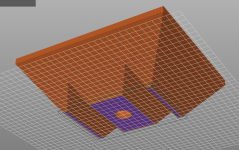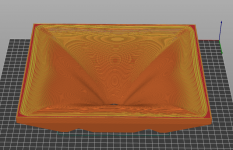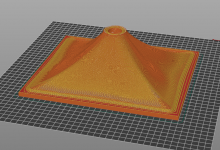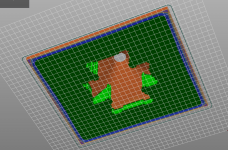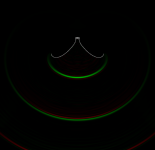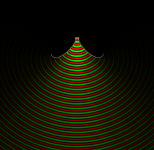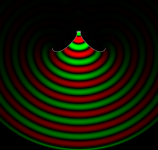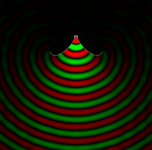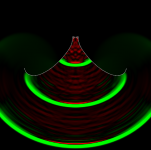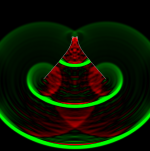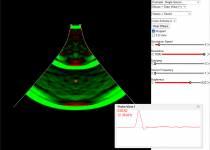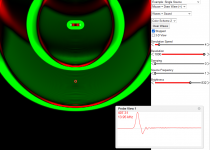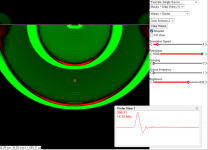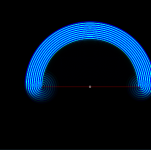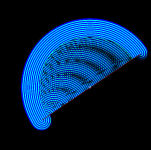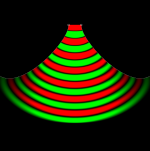Tried to employ the "no overhangs" print method to a rectangular waveguide (280 x 242 x 90 mm) - on Chiron, at 0.8 mm nozzle/0.4 mm layer the estimate is ~20 hours, which is still acceptable. And this is not fully optimized yet, it could grow in something like fractal manner. I seriously consider giving it a try.
Attachments
Printing it face-down with supports, the time estimate is roughly the same and the waveguide body is much thiner. I guess it would be a nightmare to remove all of the supports (maybe not, I don't know, but my experience with supports hasn't been always good).
Attachments
1.4" throat (a photo "just before" the two parts are joined together) -
everybody doing this? The underlying material of top profile serves as a platform to support the curves as they get more dramatic...ingenuis
my experience with supports hasn't been always good).
if you tune the support interface, they should very easily snap right off. if they are hard to remove its an indication that the support interface has too much "connection" or strength
Well that's a big IF 🙂
- It's raining outside again and I'm lazy to do complex math today, so I at least implemented export in the Falstad's ripple tank format. This might by fun. Here's the sandhorn -
- It's raining outside again and I'm lazy to do complex math today, so I at least implemented export in the Falstad's ripple tank format. This might by fun. Here's the sandhorn -
Attachments
Thanks, so far I think I can handle that, it's just a bit tedious to put it all together. I won't hesitate to ask you whenever I encounter a hitch, which I'm pretty sure will come as soon an actual measured data come into play.
Oops, the above was for 30 kHz. This is more realistic, 10 kHz -
(It seems there's a slight reflection back when the wave leaves the screen area, so this clean wavefront pattern gets disturbed. I don't think it's correct but it's probably difficult to overcome this completely in a finite simulation, I don't know.)
Edit: Hmm, this can't be 10 kHz, based on the wavelengths shown. Is there a bug in the ripple tank?
(It seems there's a slight reflection back when the wave leaves the screen area, so this clean wavefront pattern gets disturbed. I don't think it's correct but it's probably difficult to overcome this completely in a finite simulation, I don't know.)
Edit: Hmm, this can't be 10 kHz, based on the wavelengths shown. Is there a bug in the ripple tank?
Attachments
Last edited:
I have two questions, maybe to both you Marcel and also Mr. Geddes:
1) What trade-offs do you see between a rectangular waveguide with high-frequency dispersion slots like Tritonia/M2-style and an axisymmetric OS-SE waveguide?
A note aside: I began to work with a well known cheap JBL-waveguide, but was pointed at issues that narrow vertical dispersion introduces to DI around crossover frequency. See fluids post here, where he brought up kimmonosto's 1.2 lambda rule for DI optimized 2-way vertical spacing. Kimmo repeated his lesson recently over at htguide.com forums. Since then, and also because of further limitations of the current device, I want to replace the waveguide in the long term with a custom solution.
2) Would you have a recommendation, how a non-trained person (studied humanities, not science) can, over the course of some years, acquire the knowledge to design waveguides? Where to start and what could be a reasonable way of learning it for the DIYer? It can take time, does not matter, but it would be beneficial to not only use the Ath software, but really know what is happening.
Regards
Marinus
1) What trade-offs do you see between a rectangular waveguide with high-frequency dispersion slots like Tritonia/M2-style and an axisymmetric OS-SE waveguide?
A note aside: I began to work with a well known cheap JBL-waveguide, but was pointed at issues that narrow vertical dispersion introduces to DI around crossover frequency. See fluids post here, where he brought up kimmonosto's 1.2 lambda rule for DI optimized 2-way vertical spacing. Kimmo repeated his lesson recently over at htguide.com forums. Since then, and also because of further limitations of the current device, I want to replace the waveguide in the long term with a custom solution.
2) Would you have a recommendation, how a non-trained person (studied humanities, not science) can, over the course of some years, acquire the knowledge to design waveguides? Where to start and what could be a reasonable way of learning it for the DIYer? It can take time, does not matter, but it would be beneficial to not only use the Ath software, but really know what is happening.
Regards
Marinus
Last edited:
This is the source alone (undisturbed at the probe), without the waveguide -
(I still have to figure out how to setup the pulse source.)
(I still have to figure out how to setup the pulse source.)
Attachments
Last edited:
Rippletank has some problems, mainly it has limited resolution and reflection happens per pixel if you raise the brightness, try straight wall and packet source on it, brightness to full. All is fine, until you rotate the wall, now the wall is "pixelated" and million reflections emerge where in real world nothing changed (system was rotated).
Very fascinating but has its limits 🙂 Asked mr Falstadt about it and seemed he has no interest do something about it. The source is available on github and found some other similar WebGL based sources by Googling. Tried to learn it for few hours but the shader programming was something I didn't want to dive into so left it.
Very fascinating but has its limits 🙂 Asked mr Falstadt about it and seemed he has no interest do something about it. The source is available on github and found some other similar WebGL based sources by Googling. Tried to learn it for few hours but the shader programming was something I didn't want to dive into so left it.
Last edited:
Yes - Ripple Tank Simulation
The resolution can be increased in Options, this was 0.5 mm/pixel. I can try 0.125 mm.
The resolution can be increased in Options, this was 0.5 mm/pixel. I can try 0.125 mm.
Last edited:
Yeah Paul Falstad. Here illustration what I was trying to convey.
Anything but straight line and there is extra reflections happening. Anyway, it is nice to see diffraction and stuff visualized. I tried to study baffle (and enclosure) diffraction stuff with it. The UI is nightmare but luckily the elements can be generated by custom code / UI 🙂
Anything but straight line and there is extra reflections happening. Anyway, it is nice to see diffraction and stuff visualized. I tried to study baffle (and enclosure) diffraction stuff with it. The UI is nightmare but luckily the elements can be generated by custom code / UI 🙂
Attachments
Well that's a big IF 🙂
- It's raining outside again and I'm lazy to do complex math today, so I at least implemented export in the Falstad's ripple tank format. This might by fun. Here's the sandhorn -
I assume you know this is already built into Hornresp, right?
Sometimes I feel like I'm the only person in the world that uses that feature lol
My Summer is Ruined.
No, actually I have never used Hornresp. Well it took me about half an hour to learn the ripple tank definition format and to code the export function into Ath - I'm pretty self-sufficient 🙂
- So can Hornresp show internal HOMs clearly when driven with a single pulse? That would be something. Falstad's ripple tank doesn't seem to be reliable enough, as tmuikku demonstrated.
- So can Hornresp show internal HOMs clearly when driven with a single pulse? That would be something. Falstad's ripple tank doesn't seem to be reliable enough, as tmuikku demonstrated.
Last edited:
- Home
- Loudspeakers
- Multi-Way
- Acoustic Horn Design – The Easy Way (Ath4)
